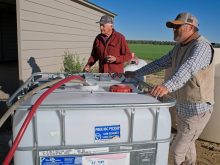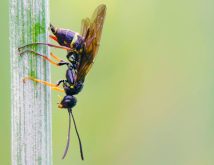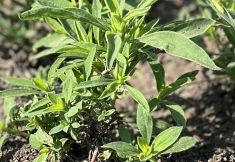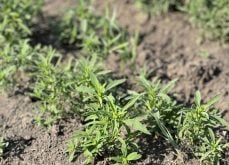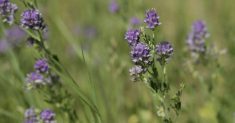Some soil nematodes are beneficial, providing important soil health benefits for crops. However, there are some that can negatively affect pulses and other crops.
According to Mario Tenuta, a University of Manitoba soil scientist, harmful soil nematodes can reduce yields by siphoning off the contents of roots and stems, robbing the plants of energy and weakening their defences against crop diseases and other pests.
“They also compromise root function,” says Tenuta. “The galls and lesions they cause reduce water and nutrient uptake and can allow secondary pathogens to enter roots and cause disease. Some nematodes vector plant viruses.”
Read Also

Cancer agency reclassifies another herbicide ‘probably carcinogenic’
The WHO’s cancer research agency has now put atrazine, a herbicide well known to corn growers, in the same potential-hazard category where the agency put glyphosate.
What’s worrisome about harmful nematodes is you may not realize you have them in your fields. Tenuta explains there are a wide range of symptoms, and next to viruses, nematodes are probably the most difficult infection to diagnose. Other symptoms aside from root galls and lesions include:
- Root rot
- Lack of fine roots
- Stem swelling and twisting
- Dwarfing/stunting
- Chlorosis
Here is an up-to-date look at nematodes that are a present or potential threat in the Prairies in pulses and other crops.
Root lesion nematode (Pratylenchus neglectus)
Tenuta says there are reports of P. neglectus causing reductions to spring peas and lentils in the Pacific Northwest. He notes it’s a potential pest for other crops as well.

“In soils with very high populations of the pest, it can reduce potato yield, but levels need to be very high. It’s also a pest of canola and wheat in Australia. Our research has shown it very much enjoys soybean and to a lesser extent chickpea,” says Tenuta. “It is recommended to examine the roots of those crops in field areas that are puzzling to sort out productivity problems. Look for black and brown lesions on roots. Get a soil nematode analysis done.”
Stem and bulb nematode (Ditylenchus dipsaci)
D. dipsaci is a serious issue for garlic producers throughout Ontario, Quebec and the northeastern United States. It infects about 500 plant species in total around the world. In terms of its potential threat on the Prairies, this pest favours yellow pea and is also a risk to dry beans.
Stem and bulb nematodes were seemingly found by the Canadian Food Inspection Agency in some yellow pea fields in Saskatchewan, southern Alberta and southwestern Manitoba in 2004. However, analysis of pea samples by Tenuta’s lab determined the nematodes were not in the peas but instead in weed seed, specifically in creeping thistle seed (a common weed in yellow pea fields in the Prairies). Through molecular analysis, Tenuta and his team also found the species was not D. dipsaci but the stem nematode of thistle (Ditylenchus weischeri).
Because D. dipsaci favours garlic, however, it remains a threat to pulse crops on the Prairies. It was found in 2014 in two garlic fields near Winnipeg, Man., caused by infected garlic bulbs imported from Ontario the previous fall.
“There are surprisingly more garlic growers on the Prairies than you’d think,” Tenuta says.
“We need to be vigilant in spotting the nematode in garlic. Look for rotting bulbs and send samples to a lab for a check.”
Soybean cyst nematode (Heterodera glycines)
Soybean cyst nematode (SCN) has been moving northward through the United States for many years. It is already well established in Ontario and will eventually spread to all soybean growing areas of Canada, like it has in the United States.
Survey efforts led by Tenuta and his colleagues that began in 2012 led to SCN being detected for the first time in Manitoba in 2019. There was another confirmed case in July 2021.
Tenuta says SCN is now in five rural Manitoba municipalities — Thompson, Norfolk Treherne, Rhineland, Emerson-Franklin and Montcalm. “Given the large gap between regions with positive identification, it may be present in other areas as well,” he notes.
As for all nematodes, identifying SCN is difficult. There are no distinct, above-ground symptoms and at low levels of infection plants may still appear healthy. At high levels of infection plants may appear stunted and chlorotic or necrotic, which could be due to many other factors. Digging up the roots is the best way to identify this pest. The most high-risk areas of a field are generally low-yielding areas, approaches and field edges, low spots, shelterbelts and high pH areas.
Tenuta recommends scouting for SCN from mid-July through September, during the nematode’s reproductive stages until maturity, by gently digging up soybean roots and examining them for cysts. It’s recommended to soak the roots in water first to avoid breaking off any cysts that may be present. Early on, cysts are white and lemon shaped. They’re also much smaller than root nodules and may require the use of a magnifying lens. “They pop between fingernails like a zit,” says Tenuta.
He adds growers can manage SCN through rotating to non-host crops and controlling host weed species. Tenuta’s list of host crop plants for SCN includes:
- Adzuki bean
- Alsike clover
- Bird’s-foot trefoil
- Black bean
- Common vetch
- Cowpea/black-eyed pea
- Cranberry bean
- Crimson clover
- Crown vetch
- Great northern bean
- Hairy vetch
- Kidney bean
- Lespedeza
- Lima bean
- Lupines
- Mung bean
- Navy bean
- Pea
- Pinto bean
- Soybean
- Snap bean
- Sweet clover
The list of host weeds for SCN includes:
- American vetch
- Carolina vetch
- Common chickweed
- Common mullein
- Field pennycress
- Hemp sesbania
- Henbit
- Hop clover
- Milk vetch
- Mouse-ear chickweed
- Pokeweed
- Purple deadnettle
- Purslane
- Shepherd’s purse
- Wild mustard
- Winged pigweed
- Wood vetch
Other ways producers can manage soybean cyst nematodes are by growing SCN-resistant varieties and reducing tillage. Tenuta says because the nematodes spread easily and rapidly, growers should thoroughly clean soil from equipment, vehicles, soil sampling gear and clothing. SCN eggs can survive for several years in the absence of a soybean crop.
Cereal cyst nematode (Heterodera avenae)
Cereal cyst nematodes have been found to reduce yields of wheat, barley and oats in the Pacific Northwest states of Idaho, Oregon and Washington, and even east to Montana. Being a cyst nematode, these nematodes look similar to SCN. Look out for them to establish most likely in southern Alberta first.
Stubby root nematode (Trichodorus and Paratrichodorus)
These nematodes have a wide range of host crops including corn, soybean and sorghum. They are found throughout the United States and in many areas of Canada. They can damage crops when they’re in soil in high populations. But the most damage they inflict comes from vectoring viruses of crops. For example, corky ringspot of potato caused by the tobacco rattle virus is vectored by stubby root nematodes (the virus is transmitted as the nematodes feed on potato roots).
Root lesion nematode (Pratylenchus penetrans)
This nematode affects potatoes and corn but has an extremely wide host range. This includes sugar beet, wheat and oat as well as three pulse crops — field pea, faba bean and chickpea. Fortunately, P. penetrans hasn’t been found in the Prairies yet, Tenuta says, but this could change as growing seasons get longer. A longer growing season increases the chances of the pest going through enough life cycles in one year to establish permanently in a field.
Pin nematode (Paratylenchus)
Tenuta’s lab, the Soil Ecology Laboratory at the University of Manitoba, has been working with Saskatchewan Pulse Growers and Michelle Hubbard, a plant pathologist with Agriculture and Agri-Food Canada in Swift Current, Sask., to determine if pin nematodes are involved in the mysterious disease affecting chickpea fields in southern Saskatchewan. They have been found in extremely high levels in the affected region and greenhouse work has shown these nematodes can reproduce on chickpea. Research is continuing to see if pin nematodes are causing the chickpea disease.
Control products
Nematicides are used to control nematodes. There really hasn’t been a need for nematicide use in the Prairies up to now, Tenuta says. However, with concerns over harmful nematodes building in the Prairies, it is good to know there are control options.
According to Tenuta, control options include a few older nematicides in carbamate and organophosphate groups. Newer products include fluensulfone, fluazaindolizine, fluopyram and cyclobutrifluram nematicides as well as fungal metabolites, plant immune stimulants and biological control groups of various soil bacteria or fungi.




